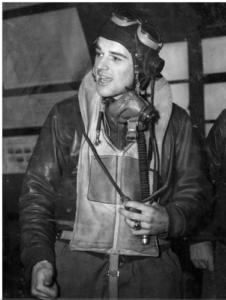 Walker Mahurin, one of the leading American fighter pilots of World War II, who downed enemy planes in Europe and the Pacific, and, later, in the Korean War, died Tuesday at his home in Newport Beach, Calif. He was 91.
Walker Mahurin, one of the leading American fighter pilots of World War II, who downed enemy planes in Europe and the Pacific, and, later, in the Korean War, died Tuesday at his home in Newport Beach, Calif. He was 91.
Enlarge This Image
Associated Press
Capt. Bud Mahurin, returning from a raid in November 1943.
His death was announced by his wife, Joan.
Having arrived in Britain in January 1943 with the Army Air Forces’ 56th Fighter Group, Mr. Mahurin, who was known as Bud, flew P-47 Thunderbolts that protected American bombers on their missions.
He downed his first two German planes in August 1943, and in November he shot down three planes in a single day during a raid on Bremen, Germany, giving him a total of 10 “kills” and making him the first “double ace” in the Eighth Air Force.
On March 27, 1944, Mr. Mahurin’s fighter was hit when he took part in shooting down a German plane during a raid on Tours, France.
He bailed out, hid in a haystack and was found by a farmer who placed him in the hands of the French Resistance, which arranged his return to England.
When he returned to the United States in June 1944, his combat days were seemingly over. Since he might be forced to provide information about the French underground if shot down again by the Germans and captured, he was not permitted to fly over Europe any longer. But he obtained a transfer to the Pacific theater and shot down a Japanese plane in the Philippines, piloting a P-51 Mustang.
By the war’s end, Mr. Mahurin had been credited with 20.75 kills, the fraction representing shared credit with other fighter pilots in some downings.
He was serving in the office of the Air Force secretary when the Korean War broke out. Arriving in South Korea in December 1951, he flew F-86 Sabre jets. He had been credited with shooting down three MIG-15s, and taking part in another downing, when he set out to strafe a rail yard in North Korea on May 13, 1952.
He decided that before heading back to base he would shoot up a truck he had spotted in the area.
“I should never have gone after that truck,” Mr. Mahurin told the Gannett News Service in 2006. “You never want to trade a $500,000 airplane for a $50,000 truck. I figured, well, I’d go shoot that up and then I’ll have a good story to tell the boys at the officers’ club when I get back to base. And of course I never got back.”
Mr. Mahurin was hit by anti-aircraft fire. He made a crash landing in a rice paddy, breaking his arm, and was captured. For the next 16 months — a period that extended beyond the armistice — he was subjected to brutal questioning and psychological torment as a prisoner of war. The Communists were trying to get downed American airmen to sign confessions that they were committing germ warfare in bombing runs.
Mr. Mahurin resisted his captors and tried to commit suicide, but he was among many American airmen who finally relented.
“Bud Mahurin at last agreed to write a ‘confession’ so full of inaccuracies and implausible information that any Western reader would know it was fiction,” John L. Frisbee wrote in Air Force magazine in 1997. “Unknown to him, the war had already ended.”
Doug Lantry, a historian at the National Museum of the United States Air Force, said Mr. Mahurin was the only pilot of the Army Air Forces and its successor, the Air Force, to have shot down enemy planes in the European and Pacific theaters in World War II as well as in Korea.
Walker Melville Mahurin, the son of an architect, was born on Dec. 5, 1918, in Benton Harbor, Mich., but grew up in Fort Wayne, Ind. He attended Purdue University before joining the military in 1941, and he returned for a bachelor’s degree after World War II.
After the Korean War, Colonel Mahurin was vice commander of the 27th Air Division. He retired from military service in 1956 and then worked for North American Aviation in Southern California.
In addition to Joan Mahurin, his second wife, he is survived by two sons, George, of Brea, Calif., and Michael, of Florida, and a daughter, Lynn Vaughn of San Juan Capistrano, Calif., all from his marriage to his first wife, Patricia, which ended in divorce; a stepdaughter, Valerie Miller of Newport Beach; and seven grandchildren.
For all the torment to which he was subjected as a prisoner of war, Mr. Mahurin looked back at his flying days as an adventure.
“That was the most fun I ever had,” he told Airman magazine in 2003, recalling his time as a Sabre jet pilot in Korea.
“You seldom think of aerial combat — getting shot at — as fun,” he said, “but it’s a lot of fun if you’re doing the shooting.”
—————————————————————————————————————
COMMENT: HAITIAN-TRUTH.ORG
Bud Mahurin was my friend.
|
As a fighter pilot I always looked up to Bud and the others who had gone before me.
Bud was a big help to me on several occasions.
They don’t make them like Bud Mahurin anymore.
Collins
Hey Dude,
I just caught wind of this you published. Really it’s a good stuff for those who are looking for WWII Airplanes.I would like to tweet on it and keep my eye behind at every moment you blogging.